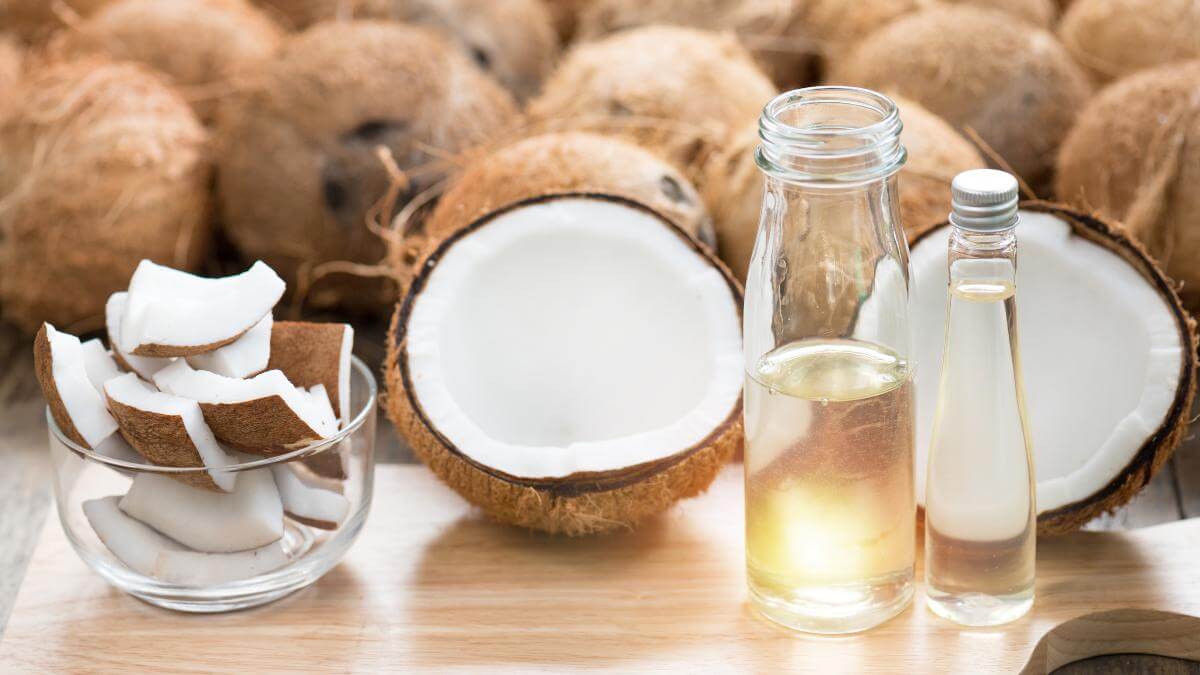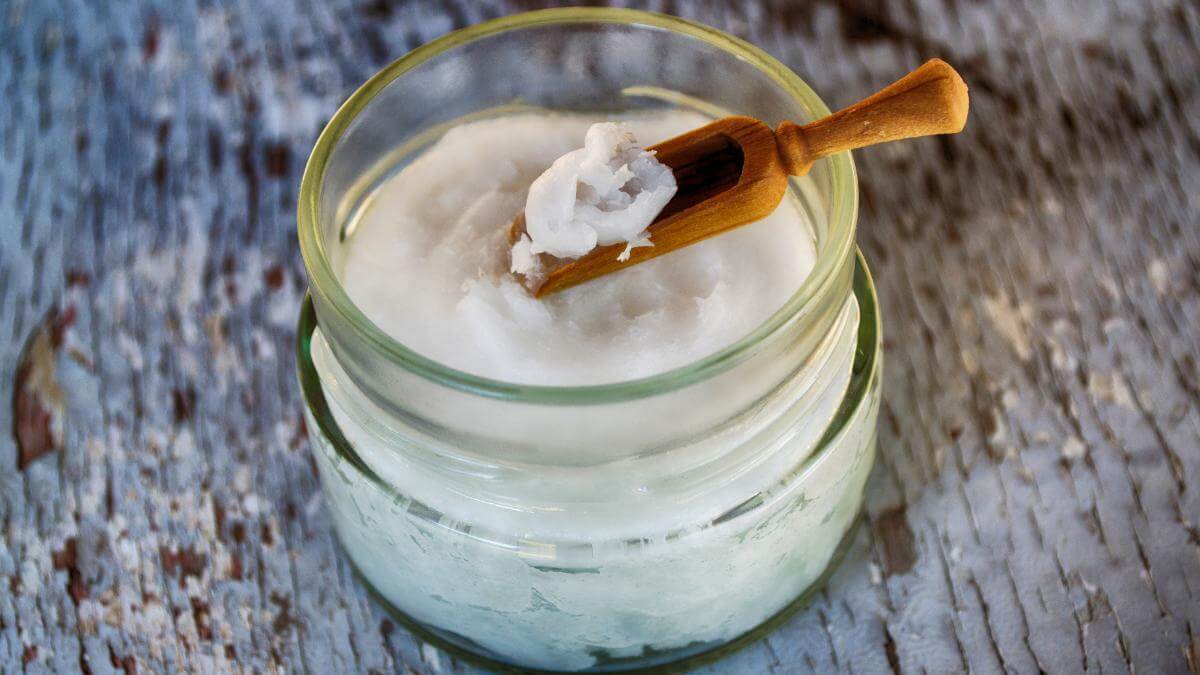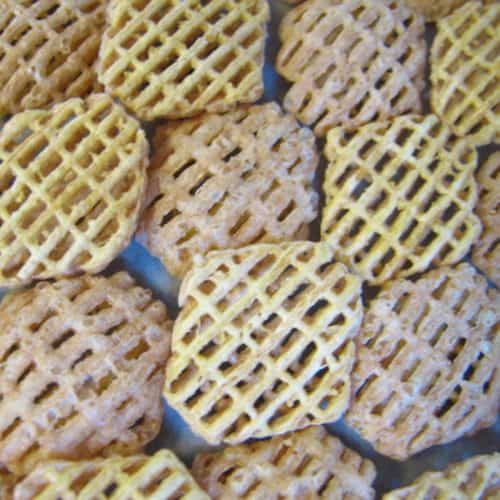Coconut oil has become increasingly popular recently, but how do you cook with it? And is it as healthy as people claim?
Cooking with coconut oil is simple and can be used in many ways. Its sweet, nutty flavor complements many foods, from curry to cookies. However, it might not be the superfood we thought it was.

Jump to:
What is Coconut Oil?
Coconut oil is oil pressed from the meat and liquid of coconuts. The word coconut is a misnomer, as coconuts are not nuts but drupes or fruits containing a single seed (like peaches). The seed of a coconut is the part we eat, lined with white, flaky "meat" and filled with the liquid we call coconut water.
Because coconut oil contains as much as 90% saturated fat, it is stable, resisting oxidation and rancidity, and typically remains solid at room temperature. It has a melting point of about 78 degrees Fahrenheit, so it might become liquid on warm summer days.
Coconut oil typically tastes like coconut and adds a very mild coconutty flavor to whatever you cook it with. It makes popcorn taste gourmet and takes black bean brownies to the next level. It's also great in homemade granola.
Don't confuse coconut oil with coconut butter: they are two entirely different things. While coconut oil is extracted from coconuts, coconut butter is made by pureeing coconut meat, resulting in something creamier and more spreadable. Coconut butter is a spread, more like peanut butter, not a cooking fat.
Refined vs. Unrefined
When shopping for coconut oil, you may have encountered terms like refined, unrefined, virgin, expeller-pressed, and cold-pressed. The options can be dizzying! So, what does all of this mean?
Refined coconut oil has been heated and possibly processed with chemicals, resulting in a very mild flavor and a high smoke point. Similarly, "expeller-pressed" means that the production process used steam or heat.
Unlike olive oil, no regulations surround the terms "virgin" and "extra virgin" for coconut oil. Theoretically, virgin coconut oil is unrefined, meaning there is little to no heat and no chemicals in its production. "Cold-pressed" means the oil is pressed without heat, likely retaining more nutrients. Unrefined coconut oil has a more robust flavor and lower smoke point.
You will most likely want unrefined coconut oil (more on this later). Look for the terms "virgin" and "cold-pressed" as well, as these typically all mean the same thing. I also recommend choosing organic whenever possible for the health of the environment and your body.

How to Store Coconut Oil
As with most cooking oils, store coconut oil in a dark, cool location. A cabinet or pantry away from heat sources is perfect, though you can also store coconut oil in the refrigerator. Never store coconut oil near the stove or oven. Mold, yellow coloring, and funky smells indicate the oil has gone rancid.
Use Coconut Oil in Moderation
Coconut oil may not be the superfood it's touted as, but don't purge it from your pantry yet. According to Ohio State University, moderation is the key to including coconut oil in a healthy diet.
Extra virgin olive oil is a great alternative to coconut oil, as it has more unsaturated fat. Other healthier oil options include avocado oil and grapeseed oil. And if you have a choice for your recipe between coconut oil and butter, you might be better off with the butter.
While coconut oil shouldn't be your go-to cooking fat, you can use it occasionally if you enjoy its flavor.
Tips for Cooking with Coconut Oil
- Coconut oil can be used as a one-to-one substitute for other cooking oils, but you will get the best results if you keep a few things in mind.
- Unrefined coconut oil can be used in most cooking applications, such as baking and medium-heat sautéing. But refined coconut oil, with its high smoke point, will hold up better for high-heat cooking.
- When you pull your coconut oil out of the cabinet in the middle of summer, it may be liquid. If this happens and you need solid oil for your recipe, measure the required amount and put it in the fridge until it solidifies again.
- Conversely, solid coconut oil quickly melts for uses that require liquid fat; place it in a saucepan over low heat or stick it in the microwave for a few seconds. Ensure your other ingredients are at least room temperature; otherwise, the coconut oil will solidify again as soon as you pour it in.
- When using coconut oil instead of butter or shortening, measure out ¼ less coconut oil than the amount of fat called for in the recipe. Coconut oil has a higher fat content, meaning you need less. Note also that it may affect the texture of baked goods, especially those that use butter and not oil. Feel free to experiment, but your best bet for baking is to find a recipe explicitly asking for coconut oil.
- Use coconut oil in dishes with flavors it will complement, such as stir-fries with gluten free soy sauce, curry, or even a simple fried egg over leftover rice. It also adds a different flavor to sautéing veggies for soups or other dishes, like gingery squash soup.
- Coconut oil enhances the flavor of recipes that call for coconut milk.
- Because coconut oil is typically solid at room temperature, it works well for desserts that do not require baking, such as truffles and no-bake cookies. Although it might make baked cookies crispy, it's great for baked desserts that call for oil, like brownies. Of course, it also adds a nice, subtle coconut flavor to these sweet treats!
- If you pop popcorn on the stovetop or in a stir-stick popper, use coconut oil as the popping oil. The popcorn will be so delicious you won't need to add any butter.
- Coconut oil can also be used in homemade nut butters that need a little extra creaminess (and naturally sweet flavor) or as a vegan butter alternative on toast. If you're not vegan, spread coconut oil on a slice of toast anyway and drizzle some honey on top. Yum!

15 Ways to Use Coconut Oil
- Add it to popped popcorn
- Make no-bake cookies
- Use it in quick breads
- Make sweets, like this toasted coconut pound cake (just replace the all purpose flour with your favorite gluten free flour)
- Coconut rice is delicious
- Use it for pancakes instead of oil
- Add to granola
- Make crispy brownies
- Add a touch of coconut flavor to roasted vegetables
- Fry eggs
- Add to coffee
- Stir a spoonful in a hot soup
- Add a tablespoon to your morning smoothie
- Use in curries
- Use it in vegan mashed potatoes instead of butter
These are just a few ideas for using this oil in the kitchen. You can also use it as a skin moisturizer, hair conditioner, and even a makeup remover in your beauty routine.
Mistakes when Cooking with Coconut Oil
When you first start cooking with coconut oil, mistakes are easy to make. Here are a few common blunders to avoid.
- First, make sure you have the correct product. That jar in your hand should say "coconut oil," not "coconut butter." The two are not interchangeable. One is a cooking oil, while the other is a spread more akin to peanut butter.
- You also want to ensure you use the right amount of coconut oil. While it can be substituted one-for-one with other cooking oils, the same is not true when swapping out butter or shortening. Butter has a higher water content than coconut oil, so use a quarter less coconut oil than the amount of butter called for.
- Pay attention, too, to whether the recipe calls for a liquid or solid fat. Use solid coconut oil instead of cold butter or shortening and liquid coconut oil instead of vegetable oil or melted butter. And remember to let your other ingredients warm to room temperature if you need liquid oil! Otherwise, you'll have a lumpy batter.
- Similarly, coconut oil is not a good choice for homemade salad dressing, as it can solidify and make your vinaigrette chunky (ew).
- Finally, don't use unrefined coconut oil for deep-frying. It has a lower smoke point than what is required for the high temperatures of deep-frying, which means you might end up with a smoky kitchen and a screaming fire alarm.
Coconut is easy to use in the kitchen and fun to experiment with. The more you use it, the more intuitive it becomes.
While coconut oil may not be as healthy as we initially believed, you can still use it in cooking occasionally to enjoy the sweet, nutty flavor it imparts to other foods. There are many delicious ways to use it in any meal, from breakfast to dessert. Just remember that moderation is key when including coconut oil in a healthy diet.
FAQ
Refrigerating this oil is unnecessary, but you must keep it in a dark place under 75 degrees Fahrenheit.
If the temperature in your storage space is above 75 degrees, coconut oil will liquify, which is perfectly normal; as soon as the temperature goes down, it will solidify again.
Coconut oil is usually dull white. If it turns green or yellow or has gray spots, it's time to get rid of it.
Learn More About Gluten Free Eating
This article originally appeared on Pink When.





Leave a Reply